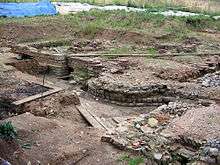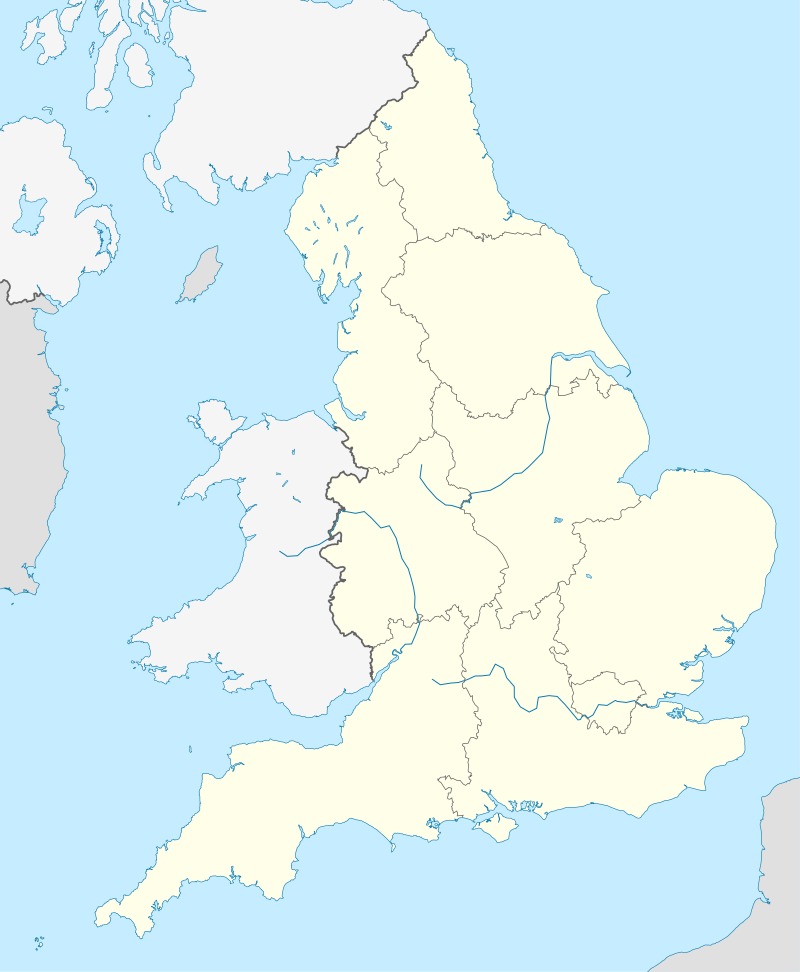Tripontium
Tripontium (Latin for "Place of three bridges") was a town in Roman Britain. It lay on the Roman road later called Watling Street (and known today as the A5) at a site now chiefly within the civil parish of Churchover in the English county of Warwickshire and partly in Leicestershire, some 3.4 miles north-east of Rugby and 3.1 miles south of Lutterworth.
 Remains of the bath houses being excavated in 2005. | |
 Shown within England | |
| Location | Warwickshire, England |
|---|---|
| Region | Britannia |
| Coordinates | 52.409152°N 1.212683°W |
| Type | Settlement |
| History | |
| Founded | Around AD 50 |
| Abandoned | 4th century |
| Periods | Roman Empire |
| Site notes | |
| Ownership | Commercial company, multiple owners |
| Public access | none |
Character
Tripontium was established as a military frontier post soon after the Roman invasion of Britain in AD 47. Its name references the bridges over the River Avon and two of its tributaries. Tripontium later developed into a civilian town which was inhabited for around 400 years, peaking in the 2nd century, before being abandoned in the late 4th century when the Romans left Britain.[1]
Excavations
The exact position of Tripontium remained a mystery for centuries, but it was found by the antiquarian Matthew Bloxam in 1836. Excavation works at the site were begun in 1961 by the Rugby Archaeological Society and have continued to 2006.[2]
From its out-of-the-way location, it was initially thought that Tripontium was a small wayside settlement of little importance. Excavations of the site have, however, revealed that it was an important Romano-British town, with large public bath houses, an extensive administrative building, and an inn (mansio) . Numerous pieces of pottery, Roman coins, and other remains have been found. Some of the area of the town has been destroyed by gravel extraction in modern times and part of the site is unavailable for excavation.[3] Nevertheless, it seems highly likely that more buildings, such as the remains of a temple or a forum, remain to be found at the site. The excavation of Tripontium has been the largest of its type to be carried out by an amateur archaeological society.
Tripontium was probably the most important Roman settlement in the area. The town is some 8 miles south of Venonae (High Cross), the point at which Watling Street crossed the Fosse Way. The large size of the bathhouses and inn have led historians to conclude that Tripontium is likely to have been an important stopping-place for travellers, both military and civilian. It was probably also an administrative centre for the surrounding area. The town was mentioned as a stopping place in the Antonine Itineraries, a third century document which recorded the places the Roman Emperors stopped and those they passed through.[4]
The site is a scheduled ancient monument.[5] It has been placed on the Heritage at Risk Register due to the risks from unlicenced metal detecting and its condition is declining.[6]
The site is not open to the public, but many of the finds from the excavations are on display at the Rugby Art Gallery and Museum.
Further reading
Tripontium, by Jack Lucas FSA (1997) ISBN 0-9531265-0-1
References
- "SITE OF TRIPONTIUM ROMAN SETTLEMENT". Our Warwickshire. Retrieved 8 October 2019.
- "Excavations and History". rugbyarchaeology.org.uk. Retrieved 5 January 2019.
- "Site of Tripontium Roman Settlement". ourwarwickshire.org.uk. Retrieved 5 January 2019.
- "Tripontium". Rugby Archaeological Society. Retrieved 5 January 2019.
- Historic England. "Tripontium Roman Station (1005759)". National Heritage List for England. Retrieved 10 June 2018.
- Heritage at Risk Register 2017, West Midlands. Heritage at Risk (Report). English Heritage. p. 43. Retrieved 10 June 2018.
External links
- Rugby Archaeological Society's website
- Heritage at Risk Register: Tripontium